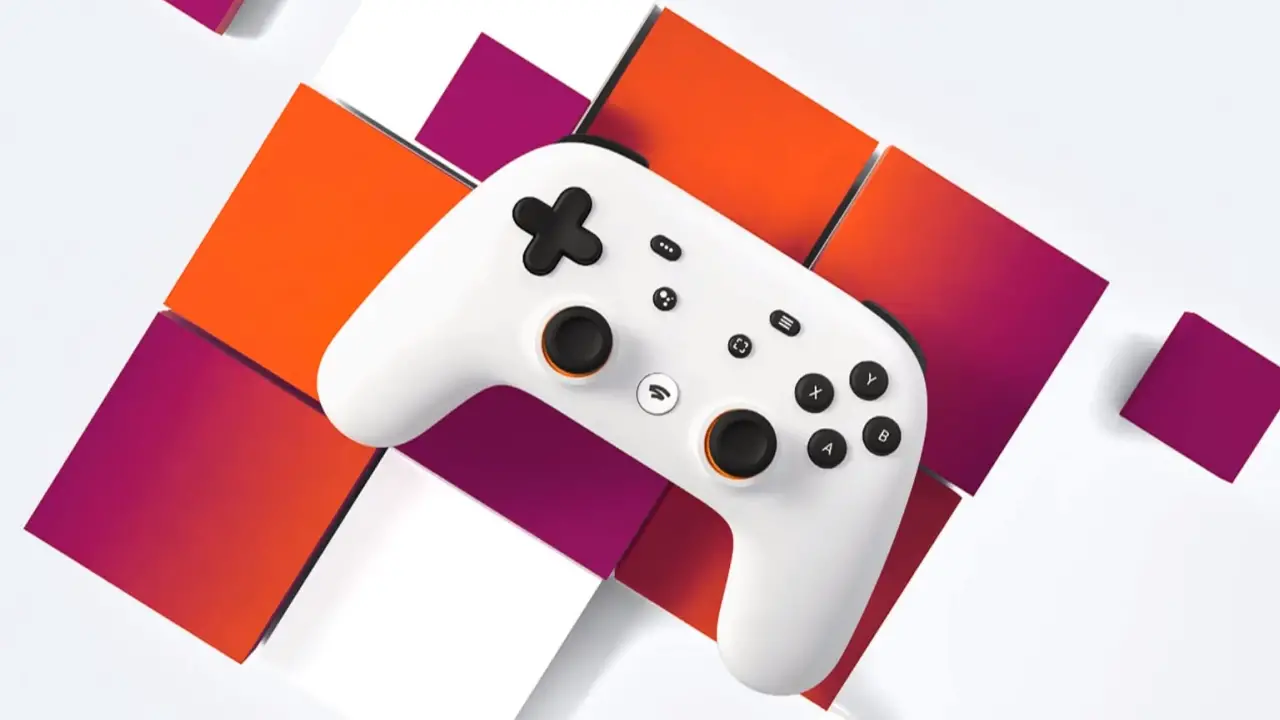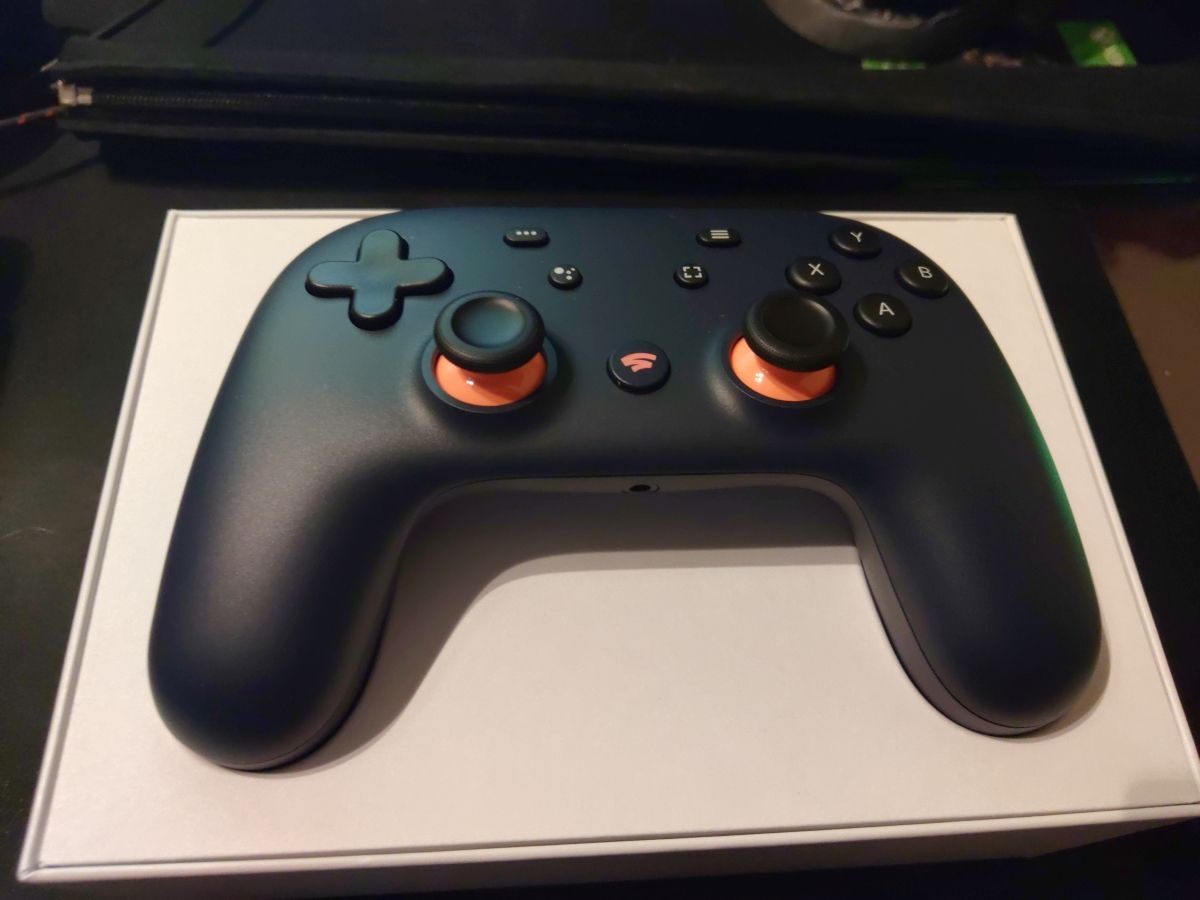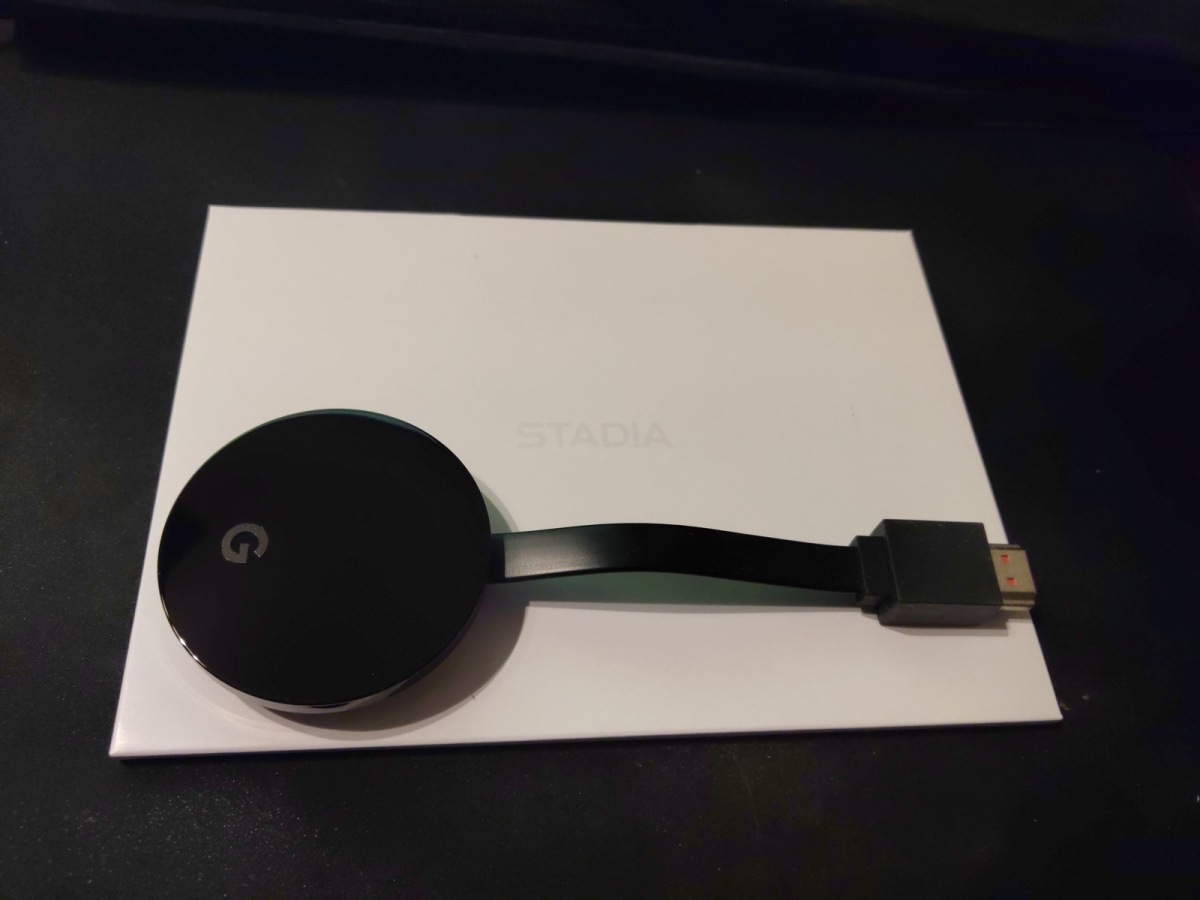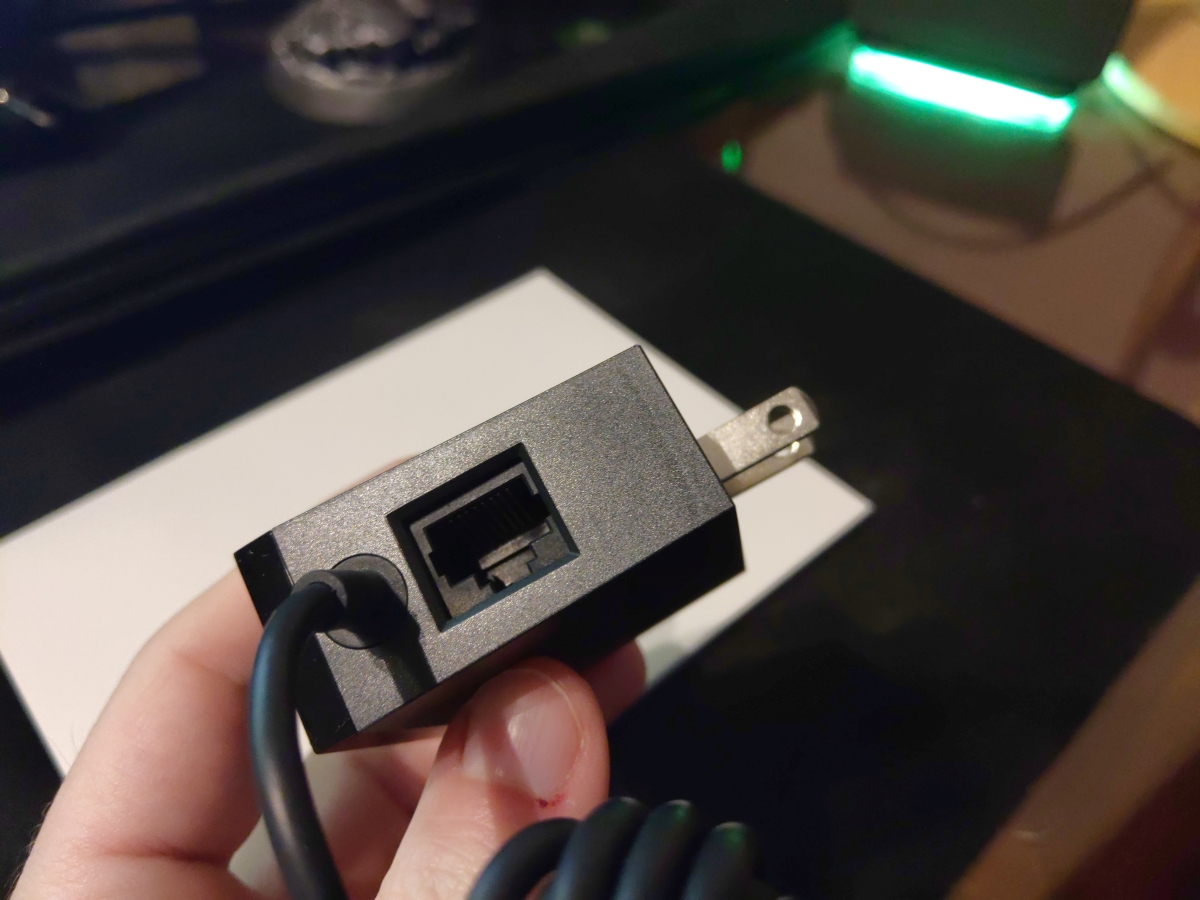
I didn’t jump on the Google Stadia hype train when the system first launched. The reason is pretty simple — I’m not the target audience. Due to my work here at Gaming Trend, I have a high end PC, and every console, but I was still curious about how a dedicated streaming platform would fare in the current gaming climate. Stadia is more narrowly focused than PC and console, emphasizing portability and flexibility in its platform, with simplicity of use being the driving force behind it. With a few months more maturity, and the second wave of big games hitting, it was time to see what Google’s console was all about.
Cracking open the box for the Founder’s Edition, you are first greeted by Google Stadia’s controller. With analog sticks in parallel, it most closely resembles a cross between a PlayStation 4 and a Nintendo Switch Pro controller. With an integrated battery that thankfully charges with an included USB-C connector, the device has a very sturdy feeling to it. Underneath the controller lies the aforementioned USB-C cable and adapter. One level below is the requisite documentation and the heart of the Stadia — the Chromecast Ultra dongle and power cable.
The proprietary power cable uses a standard-looking USB Micro-B tip, but inside the brick itself lies an Ethernet port. While the Stadia does support use over WiFi (and we’ll be testing this method, of course), your best result is always going to come from a hard wired connection. With the device powered, connected to my router, and plugged into my TV, it was time for configuration.
After a few moments you’ll be greeted with the Google Stadia logo and a prompt to configure your Chromecast with the Google Home app from the Google Play store. Moving through the prompts (Google account sign in, installation of additional optional apps like Netflix, Hulu, and even an opportunity to hook it up to Sirius XM, as examples), it was time for an update. Without the need for any user input, the device automatically updated to the latest version, taking about 2 minutes to complete the process, including the reboot. With the Chromecast Ultra set up, it was time to ready the Controller. After downloading the Google Stadia mobile app, I was able to set up my account and subscription. Stadia will eventually have a free version of the service, but currently Pro is where it’s at. The system comes with a 90 day free trial to take things for a spin, with a recurring $9.99 monthly charge for the extra bells and whistles being required thereafter. We’ll get into the differences between the service types later — stick around for a more detailed description. For now, let’s finish the controller setup.
Pressing the Stadia home button on the controller, the app immediately recognized it and started thumping the very strong vibration function to let me know that it had successfully detected the device. With the app providing the bridge, the controller then connected to my WiFi, again performing a quick unattended firmware update in the process. With the controller set up, and my accounts all squared away, the Stadia proudly proclaimed that the device is now ready to play on any TV where the Chromecast Ultra is connected. In all, a painless installation — let’s get to it.
Adding games is accomplished via the Stadia mobile app. To get rolling and to put the most strenuous test possible on the Stadia, I selected a handful of games. Just Dance 2020 would test motion controls, Wolfenstein Youngblood would be a great test of online multiplayer with a wide array of graphical bells and whistles, Mortal Kombat 11 is a fantastic high-speed latency-sensitive fighter, and DOOM Eternal is hair-on-fire fast with challenges that’ll kill you if you so much as drop a single frame. After claiming the six free games that come with a Pro subscription (Destiny 2: The Collection, GRID, GYLT, Metro Exodus, SteamWorld Dig 2, Steamworld Quest: Hand of Gilgamech, and Thumper) I nabbed those four titles.
The best thing about the Stadia, and I can’t overstate this, is that nothing requires a lengthy install. Installing DOOM Eternal on my PC took almost three hours of downloading, another 20 minutes of unpacking, and then I could finally play. Since Stadia’s experience is largely tied to your Internet connection, it’s worth stating that mine is rated at 200Mbps download, with a pathetic 6Mbps upload speed.
For every game available, I loaded each one up at least twice to see if it made any appreciable difference. It wouldn’t make any sense if it does as there isn’t enough memory in a Chromecast Ultra to cache a game like DOOM Eternal or Metro Exodus, but surprisingly… it does. I can’t explain it at all, other than possibly locally caching the content closer to me at some Google hive cluster because I requested it recently. Underneath each game, I’ll tell you how fast it loaded the first time as well as what the second run offered.
Destiny 2 – Destiny 2 was one of the premier launch titles for Google Stadia, and our resident expert Travis Northup has played more Destiny and Destiny 2 than anyone I know, so it was no surprise that he’d be all in on the review for PS4 (review), PC (review), the Curse of Osiris expansion on Xbox One (review), and Forsaken (review). While Destiny 2 has gone through a bit of a transformation as Bungie reclaimed their independence, one thing remains true — it’s a fantastic looter shooter. On the Stadia the visuals are roughly equivalent to what you’d see on an Xbox One X or a PC on high settings. It runs at 1080p which is then upsampled to 4K resolution, but after a few hours of play, I can’t say I really noticed the resolution. What I did notice, however, was that during a heavy firefight there is an occasional framerate drop. Where Destiny 2 cuts both ways is its support of cross-save, but not cross-play. On PC I can match up with a party and go get into trouble fairly instantly, but on Stadia it often took upwards of 20 minutes to match for some PvP action. Still, it’s hard to beat just how great it is to take Destiny 2 on the go by simply grabbing your controller and Chromecast Ultra. Destiny 2 took 34 seconds to load initially, with a second run taking just 12 seconds.
Mortal Kombat 11 – Mortal Kombat has always been a very twitch-based fighter, requiring crackerjack timing that won’t put up with input lag or problems with display. As you can read in our review, that hasn’t changed. In single player, I encountered the occasional tiny frame hiccup, but nothing impactful. Taking the fight online was a challenge. I left the “Looking for opponent” screen up for 30 minutes before hanging up my gloves. If you ever wanted to know why cross-play is important (and something Stadia has said simply has to be enabled by the developers on a per-game basis), this is it. Thankfully, the game is full to bursting with couch co-op action, as well as tons of single-player story fun. Mortal Kombat 11 took 33 seconds to load the first time, dropping to just 6 seconds for the second outing.
Just Dance 2020 – Just Dance 2020 requires an always-on connection, not only to Stadia, but also to the Ubisoft servers. Once you’ve gotten your UPlay account all set up (or logged in if you already have one), then you’ll need the Just Dance App for your phone. As the Stadia device doesn’t contain gyro controls, you’ll need to use your phone or similar device to fill that role. After punching in the pairing code (it wanted to use my PS4-Pro where I’ve never played Just Dance — odd) I was off to the races, dancing to the beat with my phone in my hand. As the song and the dancer movements are streamed from Ubisoft, it’s imperative that it stays in sync. Thankfully, despite the craziness of whatever was thrown my way, I didn’t see a single instance of lag in the video, or in my inputs. For a game that can get pretty fast pretty quickly (you can read all about it in our review), that’s great to see, especially when it happens to be tying two streaming services together. Just Dance 2020 took just 17 seconds to run the first time, and 15 seconds the second time.
Wolfenstein Youngblood – While it didn’t set the world on fire (our review), Wolfenstein Youngblood gave players something entirely new with cooperative gameplay courtesy of B.J. Blazkowicz’s two daughters. That’s to say that the game was built with multiplayer in mind, and nowhere is that more clear than the first second of the game where it asks you to either host or join a game instead of simply “starting”. On PC the game weighs in at a whopping 44GB to download, so it was pretty nice to be able to fire it up in just seven seconds on the Stadia. Wolfenstein Youngblood took 35 seconds to run the first time, cutting down to just 7 seconds on second launch.
Metro: Exodus – Metro: Exodus is the follow up to two of the most well-written FPS games in the last console generation, as you can see in our review. A single player experience, the game is a slower moving methodical game punctuated by fast paced insanity when the monsters go bump in the dark. One of the biggest things it has going for it is the visuals. The lighting and utilization of Ray Tracing technology may be missing here, but the game is gorgeous. It runs at 4K natively, with the only real downside being a lock at 30fps — exactly where the Xbox One X and PlayStation 4 Pro landed, but at higher resolution. That said, it doesn’t precisely hold that 30fps lock, dipping into the 20s when the action gets frantic or when there is a lot of fog or smoke. I did also notice some image quality issues that look like either compression artifacting or texture mipmapping, resulting in a chunkier edge around some surfaces. Still, it’s gorgeous, so rest assure, unless you are doing a comparison between two platforms, you’ll likely not notice it much. I did also run into an “Uh oh, the game had a glitch” error upon exit twice, but it didn’t seem to affect my save games. Metro: Exodus took 17 seconds to run the first time, and 13 seconds on second launch.
Thumper – I had a lot to say about Thumper in my review for the VR version (you can read that here), and playing it again that hasn’t changed. The game is shockingly simple and deviously difficult, taking up just 381mb, so it’s not a surprise that it shows up on the Stadia without a single compromise. The game is blisteringly fast, requiring insane precision at the higher levels. No matter how frenetic the action got, I never saw a single bit of compression artifacts or any input lag whatsoever. Thumper took 23 seconds to run for my first outing, with a second run taking just 6 seconds to execute.
DOOM Eternal – There is no doubt that DOOM Eternal looks absolutely phenomenal on the PC (as you can see in this capture at 4K/60 at Ultra Nightmare settings), and it’s very clear that literally any latency at all will get you killed immediately. In the video below you can see that the game is responsive and downright gorgeous. It loads extremely fast, and the game keeps up with the frenetic pace without too much trouble. I did notice that there are small hitches in smoothness when you are are strafing and also turning at the same time, but it is thankfully not game impacting, just creating a bit of artifacting or stuttering. You can see it at 3:49 or 17:20 in the video captured from the Stadia service over Chrome, though I was able to replicate it with the Chromecast Ultra as well, so it’s more likely the engine than a latency challenge. As you’ll see in the video, DOOM Eternal loads in just six seconds, and subsequent launches are equally as fast.
The Crew 2 – Launching on Stadia alongside a fairly huge update (their fifth free update, this one with 20 more cars, 15 new Live Summit Events, and a massive score of new cosmetics) for The Crew 2 (you can see our review for the game at launch here), this version hits the street benefiting from the last two years worth of enhancements, and it shows. The framerate is rock solid, though the dead-eyed cutscene characters still remain, and it’s not uncommon to see your character spawn inside another player in the hub areas. Still, when you are racing (and isn’t that what it’s all about?) the game performs exactly as it does on PC, Xbox One, or PlayStation 4. Despite running more than a dozen races, I didn’t see a single hiccup, hitch, or input lag problem from the Stadia version. The game hides all of its loading behind exposition and establishing shots, but the seamless transition between vehicles is instantaneous, just as it is on other platforms. It’s an excellent port. Starting the game took just 11 seconds the first time around, and 10 seconds for a second launch.
Out of their control:
Unfortunately, it’s not all sunshine and rainbows with Stadia. Your gameplay experience is largely dependent on your Internet connection, and that can make for some very painful lag, visual distortion, and even disconnects. All of the video you see above was captured in a row across the course of a two day span. I doubled back as my Destiny 2 footage wasn’t all that exciting and had this experience:
As you can see, when it’s bad, it’s really bad. My connection was stellar…until it wasn’t. I saw artifacting like this for every game I played, and sometimes the results were unplayable. And then…it cleared up. No rhyme or reason to it, beyond the incredible amount of stress ISPs are under with the COVID-19 crisis. This video compared with the Destiny 2 Strike run above is night and day. Surprisingly, even in multiplayer, my paltry 6Mbps upload was a non-factor, but the video above made it very clear that a clean high speed connection is the backbone of the Stadia experience.
How much data?
Obviously, given the streaming nature of the platform, you’ll want to be mindful of usage if you have a data cap. The natural question is “how much”, but that’s not an easy one to answer. Most games seem to utilize between 15 and 30Mbps, throttling up and down as more action happens on the screen. Thumper pretty consistently uses 14.8Mbps thanks to a very simplified presentation, but from my testing that’s an anomaly. At that rate, if you were to game for a single hour, you would use somewhere between 900mb to 1.8 Gigs of data. By way of example, in my area, AT&T has a data cap of just 50GB unless you pay them more money for an unlimited plan, charging $10 per gig after 50. You can see how streaming might obliterate your data cap in just a few days, and even faster if you are also streaming Netflix or other movie services.
Features, features, where are these features??
When Stadia launched in November of 2019, there was a roadmap of features and functionality that would not be launching with the system. Now, five months later, many are still M.I.A. Recently, 4K streaming with HDR became available, but Stream Connect, which lets players spectate and interact with the players, is still missing. Similarly, Crowd Play, which enables players to share save games and gift games to their friends is still conspicuously absent. By way of example, I was able to add friends via the app, but nowhere was a chat function available, unless it was provided in-game. There is no way to coordinate unless you simply add someone to a voice channel. Family sharing, chat, iOS support, and the Free Tier of Stadia are still on the unspecified horizon. Granted, most games will survive just fine without them, but it does make the Stadia clock in at somewhat undercooked. It’d be helpful to see an updated roadmap with dates from Google, but judging by their previous rollouts, that’s just not their style.
Titles Today and Tomorrow
At launch, Google Stadia hit the streets with 22 games. Now it has 33, including games that were released simultaneously with PC, PS4, and X1X such as DOOM: Eternal and The Division 2: Warlords of New York. On the horizon are more simultaneous launches for games like Destroy All Humans, Gods & Monsters, Marvel’s Avengers, Monster Energy Supercross 3, Watchdogs Legion, Baldur’s Gate 3 and Cyberpunk 2077 are currently announced, with 6-month exclusive titles like the co-op title Get Packed and Orcs Must Die 3. It’s likely that there are a number of unrevealed holiday titles that’ll make their way to Google’s console in addition to these, but it’s very clear that the team is beginning to gather speed.
So here we are, five months post-launch, and the question “Is Google Stadia finally worth the price of admission?” lingers in the air. It seems like the answer to that question is a resounding yes, but with the caveat that your mileage may vary. My connection of 200Mbps down and 6Mbps up seems to be more than enough for Google Stadia…when my ISP cooperates. Google suggests that 10Mbps is the bare minimum for 720p, and 35Mbps for reliable 4K, and my testing bears that out. While the country’s average speed is 100Mbps, there are plenty of areas just miles away from where I live in Texas that have 6Mbps, or even as low as 1.5Mbps. Stadia would be completely unusable for them.
Stadia’s promise and potential is clear, and is finally starting to come into focus. Things like bandwidth caps and speeds have to factor into your decision more than other traditional consoles. That said, if you’ve got the speed, there’s nothing quite like buying a game and playing it less than 10 seconds later.



